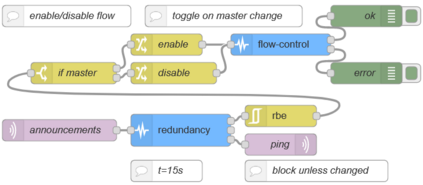Internet-of-Things (IoT) systems have spread among different application domains, from home automation to industrial manufacturing processes. The rushed development by competing vendors to meet the market demand of IoT solutions, the lack of interoperability standards, and the overall lack of a defined set of best practices have resulted in a highly complex, heterogeneous, and frangible ecosystem. Several works have been pushing towards visual programming solutions to abstract the underlying complexity and help humans reason about it. As these solutions begin to meet widespread adoption, their building blocks usually do not consider reliability issues. Node-RED, being one of the most popular tools, also lacks such mechanisms, either built-in or via extensions. In this work we present SHEN (Self-Healing Extensions for Node-RED) which provides 17 nodes that collectively enable the implementation of self-healing strategies within this visual framework. We proceed to demonstrate the feasibility and effectiveness of the approach using real devices and fault injection techniques.
翻译:从家庭自动化到工业制造过程,因特网系统在不同应用领域,从家庭自动化到工业制造过程,都分布在不同的应用领域;竞争的供应商为满足互联网解决方案的市场需求而匆忙发展,缺乏互操作性标准,以及总体缺乏一套明确的最佳做法,造成了高度复杂、多样和易碎的生态系统;有几项工作一直在推动以可视化的方案设计解决方案,以抽取基本复杂性,帮助人类了解其原因;这些解决方案开始得到广泛采用,其构件通常不考虑可靠性问题。诺德-RED是最受欢迎的工具之一,它也缺乏这种机制,无论是内部的还是扩展的。在这项工作中,我们介绍了SHHHAN(节点的自愈合扩展),它提供了17个节点,共同促成在这一视觉框架内执行自愈合战略。我们着手展示使用实际装置和错误注射技术的方法的可行性和有效性。









